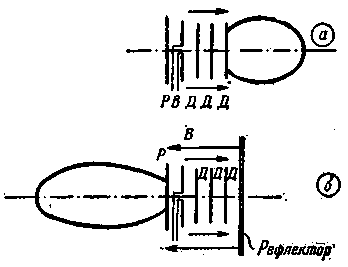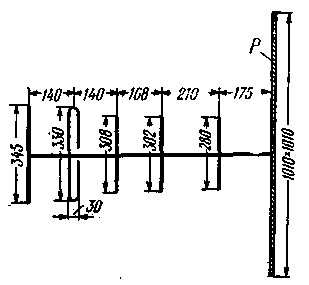Antenna with reverse radiation. Encyclopedia of radio electronics and electrical engineering

Encyclopedia of radio electronics and electrical engineering / HF antennas
 Comments on the article
Comments on the article
An antenna with reverse radiation is not much different from a wave channel type antenna, which has one or more directors, an active vibrator and a reflector. When converting a conventional antenna, a wave channel into an antenna with backward radiation, a flat reflector-wall is installed ahead of the first director at a distance of approximately 1/4 l (Fig. 1).

Rice. 1, a - antenna pattern of the wave channel;
b - antenna pattern with reverse radiation
(D - directors, V - vibrator, P - reflector).
The energy supplied to the active antenna vibrator is radiated towards the directors, reaching the reflector-wall is reflected from it (since the reflector wall is longer than K and has a pronounced inductive character), reaches the antenna vibrators again, inducing additional e .d.s.
Due to this, there is a significant narrowing of the radiation lobe and its rotation by 180 ° (that is, the energy is concentrated in a narrow direction).
In the above literature, it is reported that by attaching a reflector-wall to a conventional wave channel, it is possible to achieve a gain in return radiation of the order of 5,2 dB at a level of 0,5 compared to the wave channel antenna, the radiation angle narrows from 41 ° to 24,5 ° , side and back radiation become much smaller.
For a horizontally polarized antenna 1,5 l long with a reflector-wall (dimensions 2lx2l) and consisting of one active vibrator, three directors and three reflectors located one above the other (Fig. 2), the gain is 14,5 dB at level 0,5, 25,5; the radiation angle in the horizontal plane is 28°, in the vertical - XNUMX°.
The reflector-wall can be made of a metal sheet or a densely interwoven mesh (the latter is better due to less windage).

Rice. 2. General view of the antenna with a wall reflector.
Approximately the same result can be obtained when using a simpler wave channel antenna from one active vibrator, one director and one reflector. It is proposed to build antennas with backward radiation with a gain of 10 to 25 dB in cases where the wave channel antenna turns out to be too cumbersome, and it is not profitable to use parabolic antennas.
On fig. Figure 3 shows a relatively simple antenna for the 420 MHz band, on which measurements were made that fully confirmed the above properties of the antenna with back radiation. This antenna, without special adjustment, gives a gain of 4-4,5 dB more than the usual wave channel.

Rice. 3. Antenna with back radiation for 425 MHz
reflector-wall P is made of metal mesh,
distance between wires - 10 mm; all tube diameters
vibrators - 8 mm).
I would like our radio amateurs to start experimenting widely with such antennas, since only with good antennas can long-range reliable communications and good reception of television centers located outside the reliable reception zone be achieved.
Author: K. Fechtel (UB5WN), Kyiv; Publication: N. Bolshakov, rf.atnn.ru
 See other articles Section HF antennas.
See other articles Section HF antennas.
 Read and write useful comments on this article.
Read and write useful comments on this article.
<< Back
 Latest news of science and technology, new electronics:
Latest news of science and technology, new electronics:
Machine for thinning flowers in gardens
02.05.2024
In modern agriculture, technological progress is developing aimed at increasing the efficiency of plant care processes. The innovative Florix flower thinning machine was presented in Italy, designed to optimize the harvesting stage. This tool is equipped with mobile arms, allowing it to be easily adapted to the needs of the garden. The operator can adjust the speed of the thin wires by controlling them from the tractor cab using a joystick. This approach significantly increases the efficiency of the flower thinning process, providing the possibility of individual adjustment to the specific conditions of the garden, as well as the variety and type of fruit grown in it. After testing the Florix machine for two years on various types of fruit, the results were very encouraging. Farmers such as Filiberto Montanari, who has used a Florix machine for several years, have reported a significant reduction in the time and labor required to thin flowers.
... >>
Advanced Infrared Microscope
02.05.2024
Microscopes play an important role in scientific research, allowing scientists to delve into structures and processes invisible to the eye. However, various microscopy methods have their limitations, and among them was the limitation of resolution when using the infrared range. But the latest achievements of Japanese researchers from the University of Tokyo open up new prospects for studying the microworld. Scientists from the University of Tokyo have unveiled a new microscope that will revolutionize the capabilities of infrared microscopy. This advanced instrument allows you to see the internal structures of living bacteria with amazing clarity on the nanometer scale. Typically, mid-infrared microscopes are limited by low resolution, but the latest development from Japanese researchers overcomes these limitations. According to scientists, the developed microscope allows creating images with a resolution of up to 120 nanometers, which is 30 times higher than the resolution of traditional microscopes. ... >>
Air trap for insects
01.05.2024
Agriculture is one of the key sectors of the economy, and pest control is an integral part of this process. A team of scientists from the Indian Council of Agricultural Research-Central Potato Research Institute (ICAR-CPRI), Shimla, has come up with an innovative solution to this problem - a wind-powered insect air trap. This device addresses the shortcomings of traditional pest control methods by providing real-time insect population data. The trap is powered entirely by wind energy, making it an environmentally friendly solution that requires no power. Its unique design allows monitoring of both harmful and beneficial insects, providing a complete overview of the population in any agricultural area. “By assessing target pests at the right time, we can take necessary measures to control both pests and diseases,” says Kapil ... >>
 Random news from the Archive Random news from the Archive Three human brains tied into a net
05.10.2018
In recent years, scientists have developed tools that provide the ability to "read thoughts" and transmit them to the brain. To a very limited extent, but sufficient to demonstrate the most fundamental possibility of such an exchange of information.
In 2015, using electroencephalography (EEG) to record the electrical activity of the brain and transcranial magnetic stimulation (TMS) to relay information to the brain, researchers at the University of Washington were able to connect the brains of one participant in an experiment to those of another. During the experiment, participants played a question game.
The obvious next step was to create a network of three people. This time, the participants sent thoughts to each other while playing a Tetris-style game.
The participants were isolated from each other. Two were wearing EEG instruments. These participants saw the entire screen and could pass "commands" to rotate the figures to a third participant who only saw the top of the screen where the figures appear, but could not know whether to rotate them or not. He had to receive commands using TMS.
In order to transmit the turn command, the corresponding participant had to look at the LED on the edge of the screen flashing at a frequency of 15 Hz. A second LED flashing at a frequency of 17 Hz served to transmit the command to refuse to turn. The fact is that when perceiving flashes of light, the brain generates impulses with the same frequency, fixed by the EEG. And if certain areas of the brain are stimulated at this frequency with the help of TMS, a person experiences a sensation of flashes. Having received signals from two partners, the "receiver" carried out the command required by them.
To complicate the experiment, the scientists tried to arbitrarily change the commands received by the "receiver". So they introduced an element of error that is present in real communication. As it turned out, a person is able to distinguish correct information from false, having only the "protocol" of interaction with partners described above.
According to the researchers, the technology is easily scalable - both in terms of the number of network participants and the distances separating them.
|
 Other interesting news:
Other interesting news:
▪ AnkerMake M3 5D printer
▪ Cold and wellness
▪ Pedestrians are safer with robot cars
▪ Coffee drinkers have a lower risk of early death
▪ Bacteria found that converts methane into electricity
 News feed of science and technology, new electronics
News feed of science and technology, new electronics
 Interesting materials of the Free Technical Library:
Interesting materials of the Free Technical Library:
▪ section of the site Amateur Radio Technologies. Selection of articles
▪ article Like an apple blush. Popular expression
▪ article What is glue made of? Detailed answer
▪ article Sandblaster. Standard instruction on labor protection
▪ article Coaxial cable - inductor. Encyclopedia of radio electronics and electrical engineering
▪ article Simple experiments. Chemical experience
 Leave your comment on this article:
Leave your comment on this article:
 All languages of this page
All languages of this page
Home page | Library | Articles | Website map | Site Reviews

www.diagram.com.ua
2000-2024







 Arabic
Arabic Bengali
Bengali Chinese
Chinese English
English French
French German
German Hebrew
Hebrew Hindi
Hindi Italian
Italian Japanese
Japanese Korean
Korean Malay
Malay Polish
Polish Portuguese
Portuguese Spanish
Spanish Turkish
Turkish Ukrainian
Ukrainian Vietnamese
Vietnamese



 Leave your comment on this article:
Leave your comment on this article: